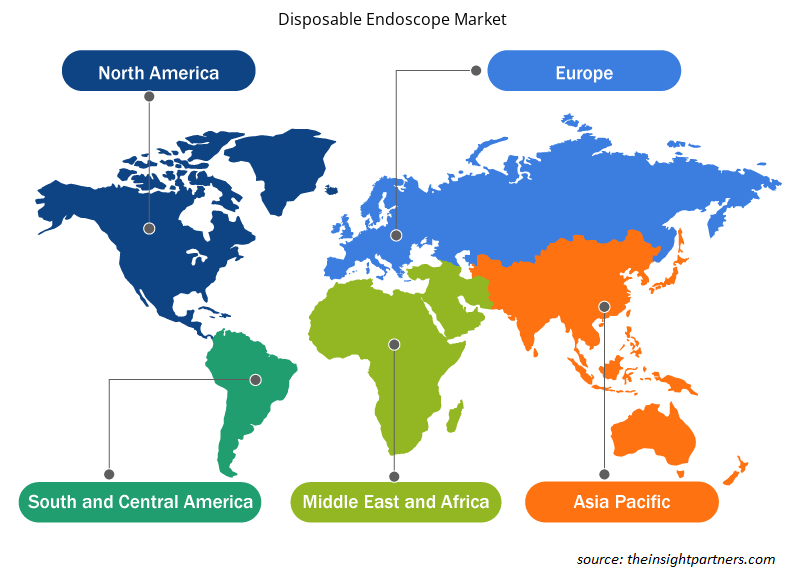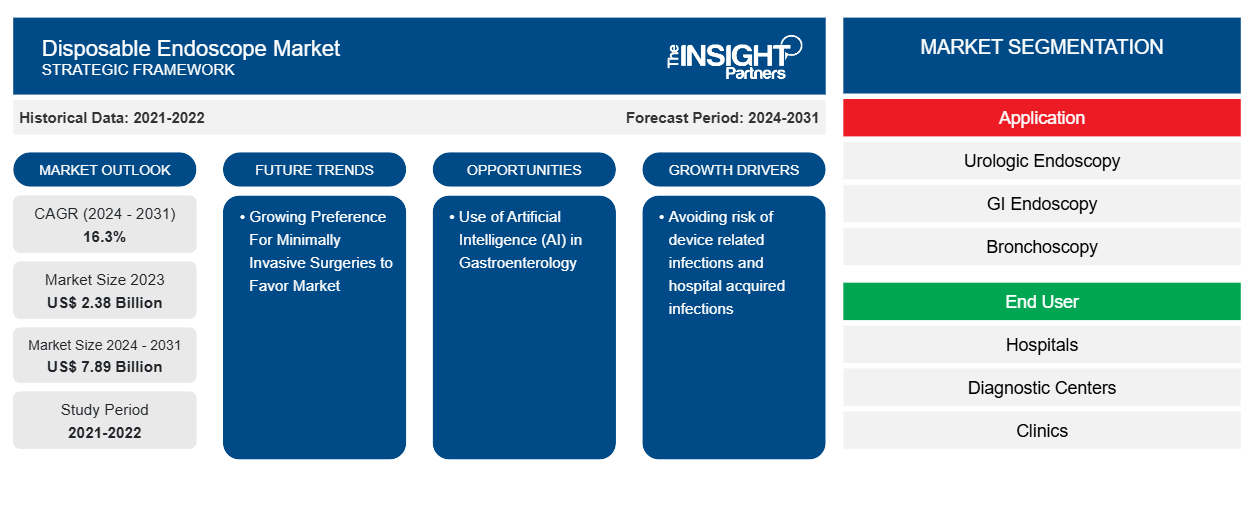一次性内窥镜市场规模预计将从 2023 年的 23.8 亿美元增至 2031 年的 78.9 亿美元。预计 2024-2031 年期间该市场的复合年增长率将达到 16.3%。避免设备相关感染和医院内感染的风险,再加上有利的政府政策,可能仍是市场的主要趋势。
一次性内窥镜市场分析
根据世界卫生组织 (WHO) 关于全球医院内感染 (HAI) 负担的报告,截至 2022 年,高收入国家的医院内感染发生率为 3.6% 至 12%,低收入和中等收入国家的医院内感染发生率为 5.4% 至 19.1%。这导致了近期一次性内窥镜设备的使用,预计在预测期内将继续保持类似的趋势。政府和其他公司增加资金和投资预计将推动整体一次性内窥镜市场的增长。
一次性内窥镜市场概况
可重复使用内窥镜的感染传播风险不断增加,这导致了一次性内窥镜市场的增长。根据 HHS.gov 的数据,截至 2021 年,大约每 31 名住院患者中就有 1 名患有与医院护理相关的感染。这些感染导致数万人死亡,美国医疗保健系统的成本每年呈指数级增长。2021 年调查中,6% 的住院患者患有一种或多种 HAI。2021 年美国急症护理医院估计有 887,000 例 HAI。约有 90,000 名患有 HAI 的医院患者在住院期间死亡。这样的因素导致了一次性内窥镜市场的增长。
定制此报告以满足您的需求
您可以免费定制任何报告,包括本报告的部分内容、国家级分析、Excel 数据包,以及为初创企业和大学提供优惠和折扣
- 获取此报告的关键市场趋势。这个免费样品将包括数据分析,从市场趋势到估计和预测。
一次性内窥镜市场驱动因素和机遇
微创手术受青睐 市场前景看好
微创手术 (MIS) 术后疼痛较少,因此患者需要的止痛药较少。由于涉及的切口或缝合很少,住院时间相对较短,患者无需频繁去医院。与传统的开放式手术相比,人们更喜欢微创手术,传统的开放式手术需要通过肌肉进行长切口。这些肌肉需要很长时间才能愈合。MIS 切口较小,恢复速度更快。此外,MIS 留下的身体疤痕几乎看不见。与传统的开放式手术相比,MIS 的主要优势在于准确性,因为视频辅助设备可以生成被手术的器官或身体部位的更好和放大的图像。由于恢复时间相对较短,这些手术在老年人群中越来越受欢迎。
根据2020年1月发表的《经鼻内镜入路岩尖解剖学研究》一文,内镜系统在微创手术中被广泛使用,用于寻找特定问题和症状的病因。传统上,大多数难以用显微镜观察的空间都可以通过内镜辅助技术暴露出来。内镜可以灵活地改变角度,通过人体自然的孔隙观察周围的解剖结构。它为外科医生提供了开阔的视野和不回缩的手术通道,大大提高了手术质量。因此,柔性内镜系统是外科医生最青睐的手术方式。
因此,导致一次性内窥镜市场增长的主要因素是对微创手术(MIS)的倾向日益增强。
人工智能(AI)在胃肠病学中的应用
人工智能 (AI) 在胃肠道 (GI) 内窥镜检查中的应用引起了广泛关注,因为它有可能在各个层面提高内窥镜检查的质量,通过提高准确性、一致性和速度来弥补人为错误和局限性。它将在胃肠道内窥镜检查的发展中取得突破和重大革命。人工智能的优势在于可以限制操作员之间的差异。它可以弥补新手内窥镜医师的有限经验以及甚至最有经验的内窥镜医师的错误。在过去的四十年中,由于体重过重的现象越来越普遍,食管腺癌 (EAC) 的发病率迅速上升。人工智能辅助在改善食管腺癌 (EAC) 的检测和诊断方面显示出良好的效果,从而降低了这种在晚期诊断时预后不良的恶性肿瘤的死亡率和发病率。
加拿大胃肠病学协会 (CAG) 成立了 AI 特别兴趣小组 (SIG),以进一步开发和推广 AI 的使用。CAG AI SIG 核心小组由来自加拿大三个省份五所机构的六名胃肠病学家组成。他们已开始使用队列研究和随机对照试验来评估 AI 技术。他们正在建立视频和数据生物库,以收集原始数据,从中可创建更多新颖的 AI 解决方案。小组成员的进一步活动包括开发和实施 AI 课程,因为需要培训下一代胃肠病学家,以便在加拿大各地的机构开发和实施 AI 解决方案。CAG AI SIG 采用开放模式,邀请新成员和 AI 研究人员加入,以最大限度地发挥这项新技术在改善内窥镜检查质量和患者预后方面的潜力。
最近,加拿大批准了一些人工智能驱动的内窥镜产品。例如,2021 年 11 月,美敦力公司的子公司美敦力加拿大 ULC 宣布,其 GI Genius 智能内窥镜模块已获得加拿大卫生部的许可。GI Genius 是一种计算机辅助检测 (CADe) 系统,它使用人工智能 (AI) 来突出显示疑似具有与不同类型的粘膜异常一致的视觉特征的结肠区域。因此,人工智能 (AI) 在胃肠病学中的应用可能会推动内窥镜检查程序的增长,这反过来又会增加一次性内窥镜的需求。
一次性内窥镜市场报告细分分析
有助于得出一次性内窥镜市场分析的关键部分是应用和最终用户。
- 根据应用,一次性内窥镜市场细分为泌尿内窥镜、胃肠内窥镜、支气管内窥镜、关节镜、直肠镜等。胃肠内窥镜领域在 2023 年占据了最大的市场份额。
- 根据最终用户,一次性内窥镜市场分为医院、诊断中心和诊所。医院部分在 2023 年占据了最大的市场份额。
一次性内窥镜市场份额地域分析
一次性内窥镜市场报告的地理范围主要分为五个区域:北美、亚太、欧洲、中东和非洲、南美和中美。
北美占据了一次性内窥镜市场的主导地位。美国医院感染病例的增加以及有利的监管环境推动了区域市场的增长。预计亚太地区将在未来几年以最高的复合年增长率增长。
一次性内窥镜市场区域洞察
Insight Partners 的分析师已详细解释了预测期内影响一次性内窥镜市场的区域趋势和因素。本节还讨论了北美、欧洲、亚太地区、中东和非洲以及南美和中美洲的一次性内窥镜市场细分和地理位置。

- 获取一次性内窥镜市场的区域特定数据
一次性内窥镜市场报告范围
| 报告属性 | 细节 |
|---|---|
| 2023 年的市场规模 | 23.8亿美元 |
| 2031 年市场规模 | 78.9 亿美元 |
| 全球复合年增长率(2024 - 2031) | 16.3% |
| 史料 | 2021-2022 |
| 预测期 | 2024-2031 |
| 涵盖的领域 | 按应用
|
| 覆盖地区和国家 | 北美
|
| 市场领导者和主要公司简介 |
|
一次性内窥镜市场参与者密度:了解其对业务动态的影响
一次性内窥镜市场正在快速增长,这得益于终端用户需求的不断增长,这些需求源于消费者偏好的不断变化、技术进步以及对产品优势的认识不断提高等因素。随着需求的增加,企业正在扩大其产品范围,进行创新以满足消费者的需求,并利用新兴趋势,从而进一步推动市场增长。
市场参与者密度是指在特定市场或行业内运营的企业或公司的分布情况。它表明在给定市场空间中,相对于其规模或总市场价值,有多少竞争对手(市场参与者)存在。
一次性内窥镜市场的主要运营公司有:
- 波士顿科学公司
- 安布公司
- KARL STORZ 内窥镜美国分公司
- ProSurg 公司
- Hillrom 服务公司
免责声明:上面列出的公司没有按照任何特定顺序排列。

- 了解一次性内窥镜市场顶级关键参与者概况
一次性内窥镜市场新闻及最新发展
一次性内窥镜市场通过收集一手和二手研究后的定性和定量数据进行评估,其中包括重要的公司出版物、协会数据和数据库。以下列出了一次性内窥镜市场的一些发展情况:
- 庆应义塾大学和 Air Water Inc. 利用渐变折射率塑料光纤 (GI-POF) 技术开发了超细硬质内窥镜。内窥镜具有 GI-POF 镜头尖端,可将图像从体内传输到体外。GI-POF 镜头的外径可薄至 0.1 毫米至 0.5 毫米,从而可以微创(对患者的身体负担较小)观察关节内部。此外,生产成本低,镜头可以像注射器针头一样一次性使用(一次性使用)。(来源:AIR WATER INC,新闻稿,2023 年 5 月)
- 内窥镜领域领先公司之一 PENTAX Medical Europe 为其新型一次性支气管镜 PENTAX Medical ONE Pulmo 获得了 CE 标志。该产品提供高质量护理,同时不影响肺部护理。PENTAX Medical ONE Pulmo 是一款一次性支气管镜,具有卓越的吸力和高清图像质量。(来源:PENTAX Medical Europe,新闻稿,2021 年 5 月)
一次性内窥镜市场报告覆盖范围和交付成果
“一次性内窥镜市场规模和预测(2021-2031)”报告对以下领域进行了详细的市场分析:
- 一次性内窥镜市场规模及全球、区域和国家层面所有主要细分市场的预测
- 一次性内窥镜市场趋势以及市场动态,如驱动因素、限制因素和关键机遇
- 详细的 PEST/波特五力分析和 SWOT 分析
- 一次性内窥镜市场分析涵盖主要市场趋势、全球和区域框架、主要参与者、法规和最新市场发展
- 行业格局和竞争分析,涵盖市场集中度、热点图分析、知名参与者以及一次性内窥镜市场的最新发展
- 详细的公司简介
- 历史分析(2 年)、基准年、预测(7 年)及复合年增长率
- PEST 和 SWOT 分析
- 市场规模价值/数量 - 全球、区域、国家
- 行业和竞争格局
- Excel 数据集



Report Coverage
Revenue forecast, Company Analysis, Industry landscape, Growth factors, and Trends

Segment Covered
This text is related
to segments covered.

Regional Scope
North America, Europe, Asia Pacific, Middle East & Africa, South & Central America

Country Scope
This text is related
to country scope.
常见问题
North America has dominated the disposable endoscope market in 2023
Avoiding risk of device related infections and hospital acquired infections coupled with favourable government scenario are likely to remain key trends in the market.
Newer product launches are future trends that will drive the overall disposable endoscope market during the forecast period 2024-2031
Boston Scientific Corporation; Ambu A/S; KARL STORZ Endoscopy-America; ProSurg Inc.; Hillrom Services, Inc.; Zsquare; Fujifilm Holdings Corporation; Pentax Medical; Scoutcam; Verathon Inc. are some leading players operating in the disposable endoscope market
The disposable endoscope market size is projected to reach US$ 7.89 billion by 2031
The global disposable endoscope market is estimated to register a CAGR of 16.3% during the forecast period 2024-2031
Trends and growth analysis reports related to Life Sciences : READ MORE..
The Insight Partners performs research in 4 major stages: Data Collection & Secondary Research, Primary Research, Data Analysis and Data Triangulation & Final Review.
- Data Collection and Secondary Research:
As a market research and consulting firm operating from a decade, we have published and advised several client across the globe. First step for any study will start with an assessment of currently available data and insights from existing reports. Further, historical and current market information is collected from Investor Presentations, Annual Reports, SEC Filings, etc., and other information related to company’s performance and market positioning are gathered from Paid Databases (Factiva, Hoovers, and Reuters) and various other publications available in public domain.
Several associations trade associates, technical forums, institutes, societies and organization are accessed to gain technical as well as market related insights through their publications such as research papers, blogs and press releases related to the studies are referred to get cues about the market. Further, white papers, journals, magazines, and other news articles published in last 3 years are scrutinized and analyzed to understand the current market trends.
- Primary Research:
The primarily interview analysis comprise of data obtained from industry participants interview and answers to survey questions gathered by in-house primary team.
For primary research, interviews are conducted with industry experts/CEOs/Marketing Managers/VPs/Subject Matter Experts from both demand and supply side to get a 360-degree view of the market. The primary team conducts several interviews based on the complexity of the markets to understand the various market trends and dynamics which makes research more credible and precise.
A typical research interview fulfils the following functions:
- Provides first-hand information on the market size, market trends, growth trends, competitive landscape, and outlook
- Validates and strengthens in-house secondary research findings
- Develops the analysis team’s expertise and market understanding
Primary research involves email interactions and telephone interviews for each market, category, segment, and sub-segment across geographies. The participants who typically take part in such a process include, but are not limited to:
- Industry participants: VPs, business development managers, market intelligence managers and national sales managers
- Outside experts: Valuation experts, research analysts and key opinion leaders specializing in the electronics and semiconductor industry.
Below is the breakup of our primary respondents by company, designation, and region:

Once we receive the confirmation from primary research sources or primary respondents, we finalize the base year market estimation and forecast the data as per the macroeconomic and microeconomic factors assessed during data collection.
- Data Analysis:
Once data is validated through both secondary as well as primary respondents, we finalize the market estimations by hypothesis formulation and factor analysis at regional and country level.
- Macro-Economic Factor Analysis:
We analyse macroeconomic indicators such the gross domestic product (GDP), increase in the demand for goods and services across industries, technological advancement, regional economic growth, governmental policies, the influence of COVID-19, PEST analysis, and other aspects. This analysis aids in setting benchmarks for various nations/regions and approximating market splits. Additionally, the general trend of the aforementioned components aid in determining the market's development possibilities.
- Country Level Data:
Various factors that are especially aligned to the country are taken into account to determine the market size for a certain area and country, including the presence of vendors, such as headquarters and offices, the country's GDP, demand patterns, and industry growth. To comprehend the market dynamics for the nation, a number of growth variables, inhibitors, application areas, and current market trends are researched. The aforementioned elements aid in determining the country's overall market's growth potential.
- Company Profile:
The “Table of Contents” is formulated by listing and analyzing more than 25 - 30 companies operating in the market ecosystem across geographies. However, we profile only 10 companies as a standard practice in our syndicate reports. These 10 companies comprise leading, emerging, and regional players. Nonetheless, our analysis is not restricted to the 10 listed companies, we also analyze other companies present in the market to develop a holistic view and understand the prevailing trends. The “Company Profiles” section in the report covers key facts, business description, products & services, financial information, SWOT analysis, and key developments. The financial information presented is extracted from the annual reports and official documents of the publicly listed companies. Upon collecting the information for the sections of respective companies, we verify them via various primary sources and then compile the data in respective company profiles. The company level information helps us in deriving the base number as well as in forecasting the market size.
- Developing Base Number:
Aggregation of sales statistics (2020-2022) and macro-economic factor, and other secondary and primary research insights are utilized to arrive at base number and related market shares for 2022. The data gaps are identified in this step and relevant market data is analyzed, collected from paid primary interviews or databases. On finalizing the base year market size, forecasts are developed on the basis of macro-economic, industry and market growth factors and company level analysis.
- Data Triangulation and Final Review:
The market findings and base year market size calculations are validated from supply as well as demand side. Demand side validations are based on macro-economic factor analysis and benchmarks for respective regions and countries. In case of supply side validations, revenues of major companies are estimated (in case not available) based on industry benchmark, approximate number of employees, product portfolio, and primary interviews revenues are gathered. Further revenue from target product/service segment is assessed to avoid overshooting of market statistics. In case of heavy deviations between supply and demand side values, all thes steps are repeated to achieve synchronization.
We follow an iterative model, wherein we share our research findings with Subject Matter Experts (SME’s) and Key Opinion Leaders (KOLs) until consensus view of the market is not formulated – this model negates any drastic deviation in the opinions of experts. Only validated and universally acceptable research findings are quoted in our reports.
We have important check points that we use to validate our research findings – which we call – data triangulation, where we validate the information, we generate from secondary sources with primary interviews and then we re-validate with our internal data bases and Subject matter experts. This comprehensive model enables us to deliver high quality, reliable data in shortest possible time.


 获取此报告的免费样本
获取此报告的免费样本